Evidence-Based Nursing Practice for Pain Management: A Report
VerifiedAdded on 2022/10/01
|8
|2084
|237
Report
AI Summary
This report focuses on evidence-based nursing practices for pain management, emphasizing the critical role of nurses in caring for patients experiencing both chronic and acute pain. It highlights the importance of sensitive patient assessment, including pain history, disability, and medication considerations. The report underscores the significance of using tools like pain management charts and summative indexes to effectively manage patient pain. The report reviews peer-reviewed evidence, demonstrating that inadequate pain management can lead to negative psychological and physical outcomes. It explores the importance of documentation, review of medical decisions, and the use of relevant literature to improve patient care. The report also discusses the use of both pharmacological and non-pharmacological interventions, including massage, relaxation techniques, and acupuncture. It emphasizes the need for continuous knowledge updates and the use of evidence-based practices to avoid clinical errors and legal issues. Overall, the report stresses the importance of improving nursing competency and the use of evidence-based practices to enhance clinical standards and patient outcomes.
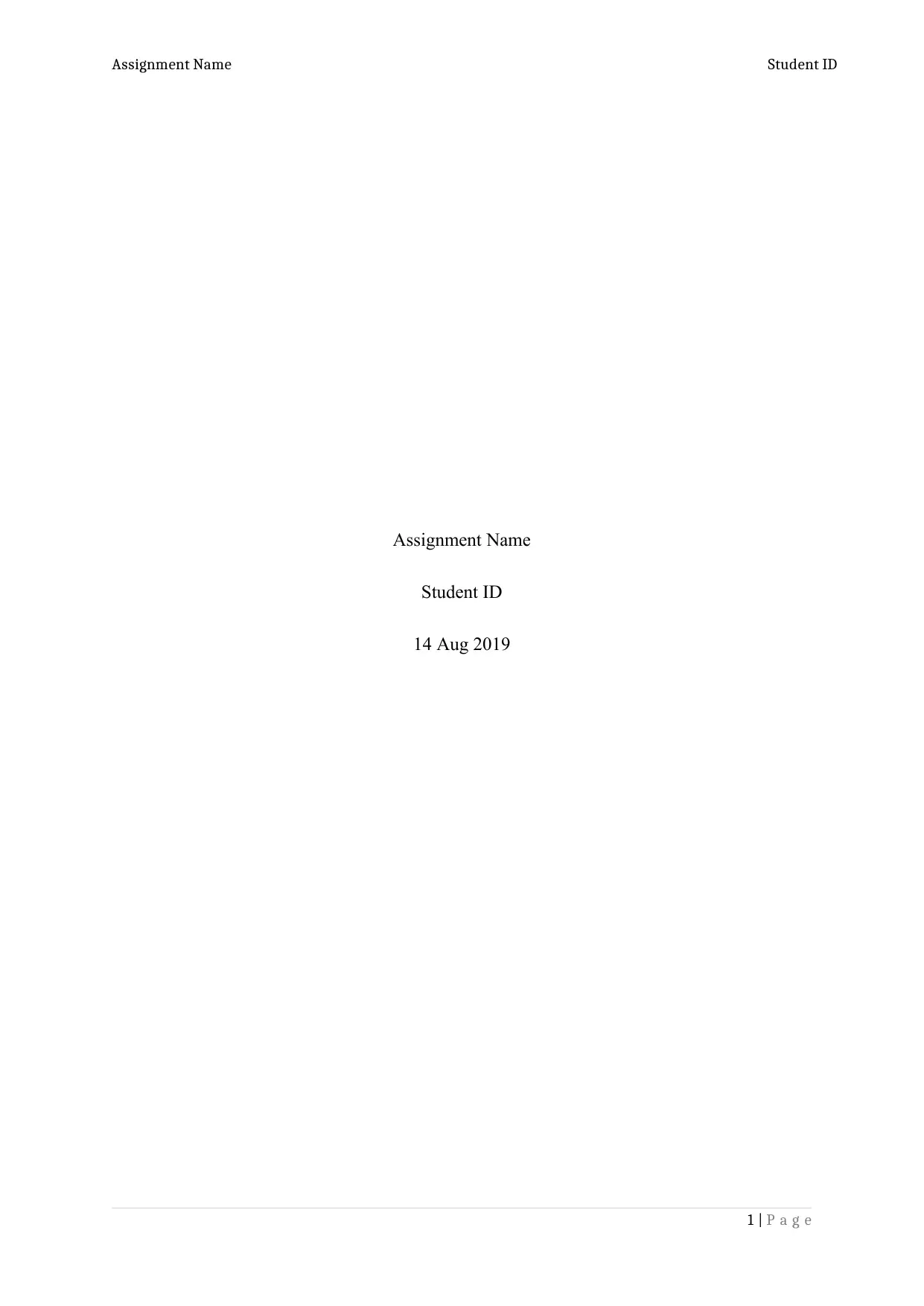
Assignment Name Student ID
Assignment Name
Student ID
14 Aug 2019
1 | P a g e
Assignment Name
Student ID
14 Aug 2019
1 | P a g e
Paraphrase This Document
Need a fresh take? Get an instant paraphrase of this document with our AI Paraphraser
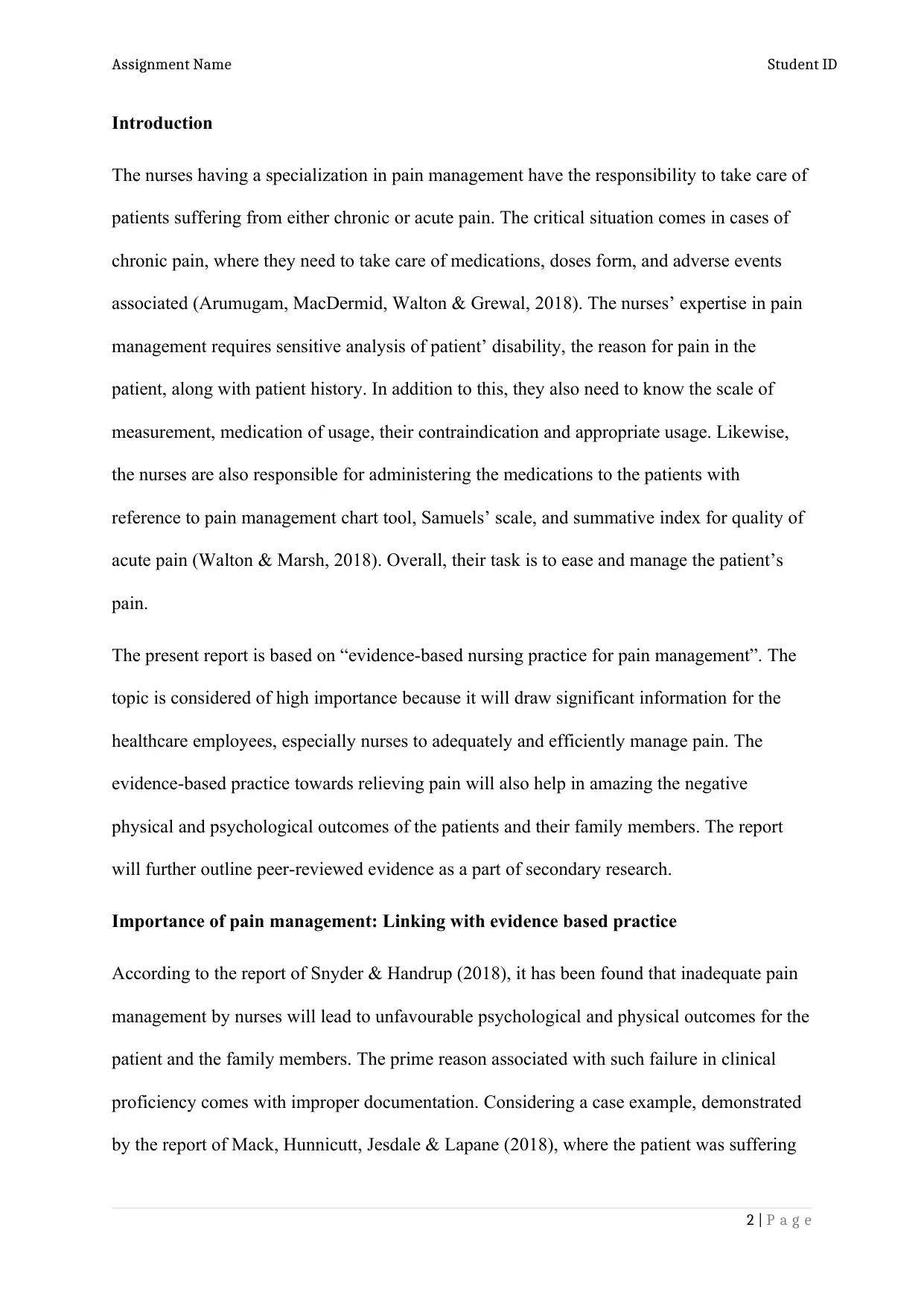
Assignment Name Student ID
Introduction
The nurses having a specialization in pain management have the responsibility to take care of
patients suffering from either chronic or acute pain. The critical situation comes in cases of
chronic pain, where they need to take care of medications, doses form, and adverse events
associated (Arumugam, MacDermid, Walton & Grewal, 2018). The nurses’ expertise in pain
management requires sensitive analysis of patient’ disability, the reason for pain in the
patient, along with patient history. In addition to this, they also need to know the scale of
measurement, medication of usage, their contraindication and appropriate usage. Likewise,
the nurses are also responsible for administering the medications to the patients with
reference to pain management chart tool, Samuels’ scale, and summative index for quality of
acute pain (Walton & Marsh, 2018). Overall, their task is to ease and manage the patient’s
pain.
The present report is based on “evidence-based nursing practice for pain management”. The
topic is considered of high importance because it will draw significant information for the
healthcare employees, especially nurses to adequately and efficiently manage pain. The
evidence-based practice towards relieving pain will also help in amazing the negative
physical and psychological outcomes of the patients and their family members. The report
will further outline peer-reviewed evidence as a part of secondary research.
Importance of pain management: Linking with evidence based practice
According to the report of Snyder & Handrup (2018), it has been found that inadequate pain
management by nurses will lead to unfavourable psychological and physical outcomes for the
patient and the family members. The prime reason associated with such failure in clinical
proficiency comes with improper documentation. Considering a case example, demonstrated
by the report of Mack, Hunnicutt, Jesdale & Lapane (2018), where the patient was suffering
2 | P a g e
Introduction
The nurses having a specialization in pain management have the responsibility to take care of
patients suffering from either chronic or acute pain. The critical situation comes in cases of
chronic pain, where they need to take care of medications, doses form, and adverse events
associated (Arumugam, MacDermid, Walton & Grewal, 2018). The nurses’ expertise in pain
management requires sensitive analysis of patient’ disability, the reason for pain in the
patient, along with patient history. In addition to this, they also need to know the scale of
measurement, medication of usage, their contraindication and appropriate usage. Likewise,
the nurses are also responsible for administering the medications to the patients with
reference to pain management chart tool, Samuels’ scale, and summative index for quality of
acute pain (Walton & Marsh, 2018). Overall, their task is to ease and manage the patient’s
pain.
The present report is based on “evidence-based nursing practice for pain management”. The
topic is considered of high importance because it will draw significant information for the
healthcare employees, especially nurses to adequately and efficiently manage pain. The
evidence-based practice towards relieving pain will also help in amazing the negative
physical and psychological outcomes of the patients and their family members. The report
will further outline peer-reviewed evidence as a part of secondary research.
Importance of pain management: Linking with evidence based practice
According to the report of Snyder & Handrup (2018), it has been found that inadequate pain
management by nurses will lead to unfavourable psychological and physical outcomes for the
patient and the family members. The prime reason associated with such failure in clinical
proficiency comes with improper documentation. Considering a case example, demonstrated
by the report of Mack, Hunnicutt, Jesdale & Lapane (2018), where the patient was suffering
2 | P a g e
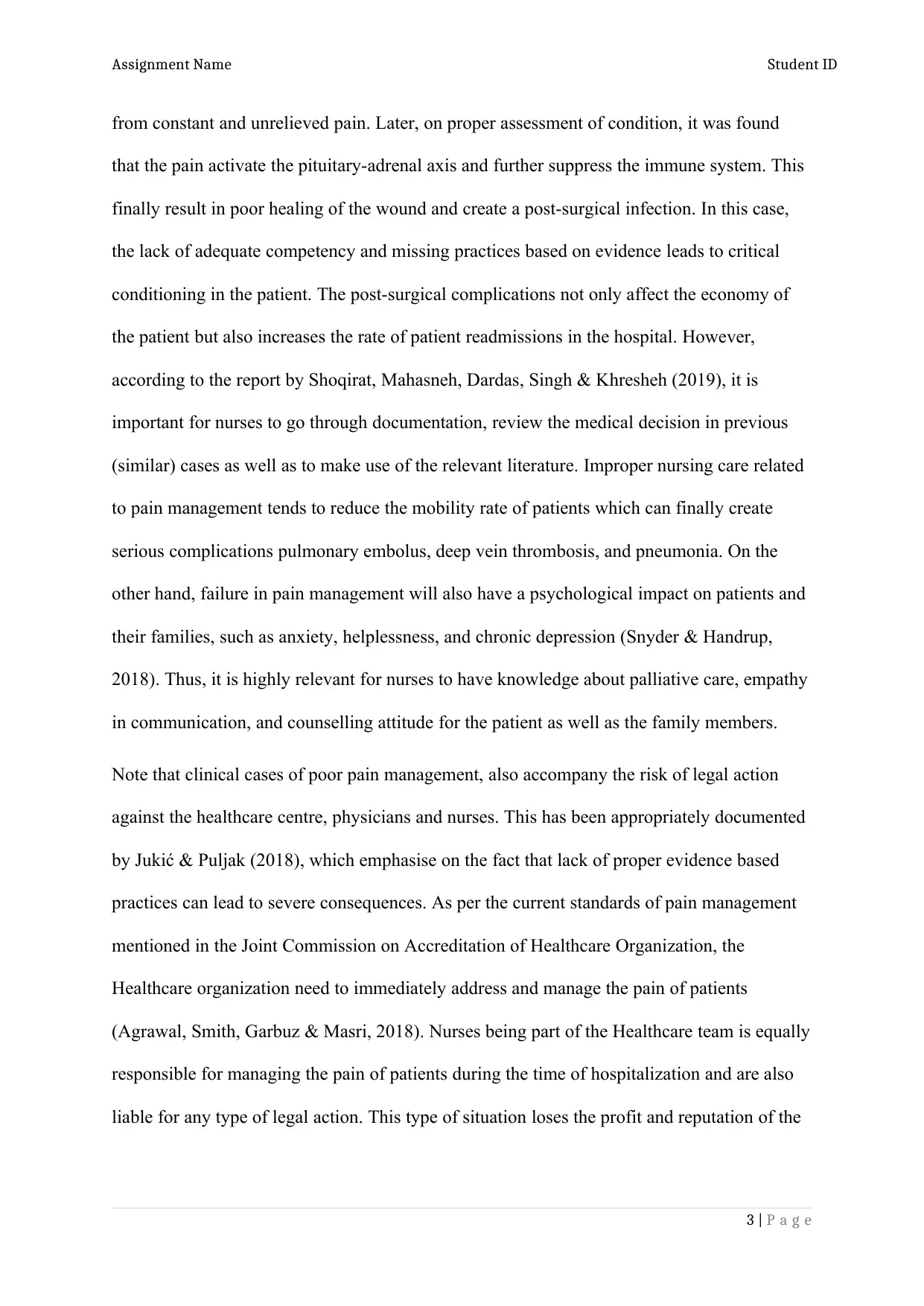
Assignment Name Student ID
from constant and unrelieved pain. Later, on proper assessment of condition, it was found
that the pain activate the pituitary-adrenal axis and further suppress the immune system. This
finally result in poor healing of the wound and create a post-surgical infection. In this case,
the lack of adequate competency and missing practices based on evidence leads to critical
conditioning in the patient. The post-surgical complications not only affect the economy of
the patient but also increases the rate of patient readmissions in the hospital. However,
according to the report by Shoqirat, Mahasneh, Dardas, Singh & Khresheh (2019), it is
important for nurses to go through documentation, review the medical decision in previous
(similar) cases as well as to make use of the relevant literature. Improper nursing care related
to pain management tends to reduce the mobility rate of patients which can finally create
serious complications pulmonary embolus, deep vein thrombosis, and pneumonia. On the
other hand, failure in pain management will also have a psychological impact on patients and
their families, such as anxiety, helplessness, and chronic depression (Snyder & Handrup,
2018). Thus, it is highly relevant for nurses to have knowledge about palliative care, empathy
in communication, and counselling attitude for the patient as well as the family members.
Note that clinical cases of poor pain management, also accompany the risk of legal action
against the healthcare centre, physicians and nurses. This has been appropriately documented
by Jukić & Puljak (2018), which emphasise on the fact that lack of proper evidence based
practices can lead to severe consequences. As per the current standards of pain management
mentioned in the Joint Commission on Accreditation of Healthcare Organization, the
Healthcare organization need to immediately address and manage the pain of patients
(Agrawal, Smith, Garbuz & Masri, 2018). Nurses being part of the Healthcare team is equally
responsible for managing the pain of patients during the time of hospitalization and are also
liable for any type of legal action. This type of situation loses the profit and reputation of the
3 | P a g e
from constant and unrelieved pain. Later, on proper assessment of condition, it was found
that the pain activate the pituitary-adrenal axis and further suppress the immune system. This
finally result in poor healing of the wound and create a post-surgical infection. In this case,
the lack of adequate competency and missing practices based on evidence leads to critical
conditioning in the patient. The post-surgical complications not only affect the economy of
the patient but also increases the rate of patient readmissions in the hospital. However,
according to the report by Shoqirat, Mahasneh, Dardas, Singh & Khresheh (2019), it is
important for nurses to go through documentation, review the medical decision in previous
(similar) cases as well as to make use of the relevant literature. Improper nursing care related
to pain management tends to reduce the mobility rate of patients which can finally create
serious complications pulmonary embolus, deep vein thrombosis, and pneumonia. On the
other hand, failure in pain management will also have a psychological impact on patients and
their families, such as anxiety, helplessness, and chronic depression (Snyder & Handrup,
2018). Thus, it is highly relevant for nurses to have knowledge about palliative care, empathy
in communication, and counselling attitude for the patient as well as the family members.
Note that clinical cases of poor pain management, also accompany the risk of legal action
against the healthcare centre, physicians and nurses. This has been appropriately documented
by Jukić & Puljak (2018), which emphasise on the fact that lack of proper evidence based
practices can lead to severe consequences. As per the current standards of pain management
mentioned in the Joint Commission on Accreditation of Healthcare Organization, the
Healthcare organization need to immediately address and manage the pain of patients
(Agrawal, Smith, Garbuz & Masri, 2018). Nurses being part of the Healthcare team is equally
responsible for managing the pain of patients during the time of hospitalization and are also
liable for any type of legal action. This type of situation loses the profit and reputation of the
3 | P a g e
⊘ This is a preview!⊘
Do you want full access?
Subscribe today to unlock all pages.

Trusted by 1+ million students worldwide
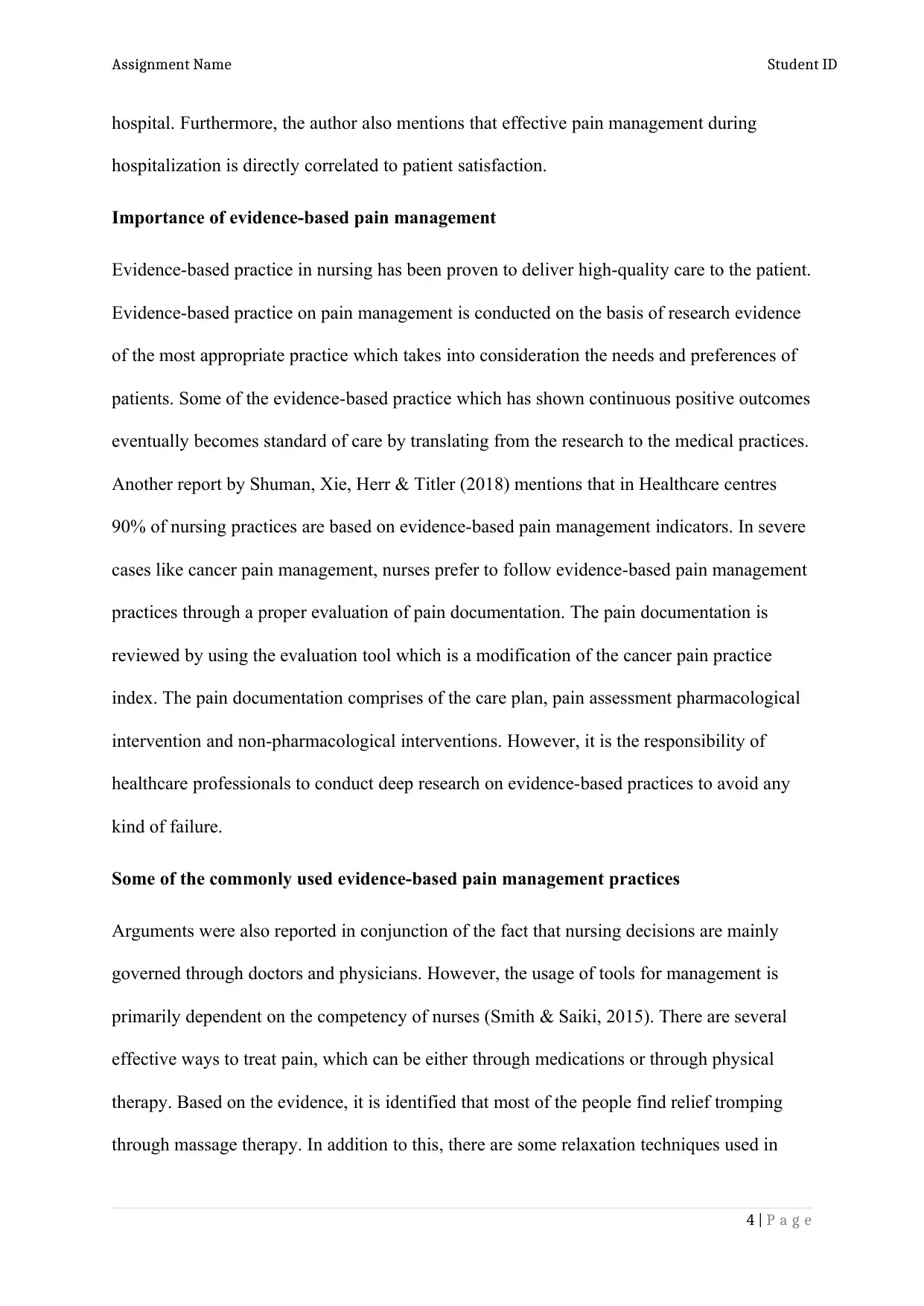
Assignment Name Student ID
hospital. Furthermore, the author also mentions that effective pain management during
hospitalization is directly correlated to patient satisfaction.
Importance of evidence-based pain management
Evidence-based practice in nursing has been proven to deliver high-quality care to the patient.
Evidence-based practice on pain management is conducted on the basis of research evidence
of the most appropriate practice which takes into consideration the needs and preferences of
patients. Some of the evidence-based practice which has shown continuous positive outcomes
eventually becomes standard of care by translating from the research to the medical practices.
Another report by Shuman, Xie, Herr & Titler (2018) mentions that in Healthcare centres
90% of nursing practices are based on evidence-based pain management indicators. In severe
cases like cancer pain management, nurses prefer to follow evidence-based pain management
practices through a proper evaluation of pain documentation. The pain documentation is
reviewed by using the evaluation tool which is a modification of the cancer pain practice
index. The pain documentation comprises of the care plan, pain assessment pharmacological
intervention and non-pharmacological interventions. However, it is the responsibility of
healthcare professionals to conduct deep research on evidence-based practices to avoid any
kind of failure.
Some of the commonly used evidence-based pain management practices
Arguments were also reported in conjunction of the fact that nursing decisions are mainly
governed through doctors and physicians. However, the usage of tools for management is
primarily dependent on the competency of nurses (Smith & Saiki, 2015). There are several
effective ways to treat pain, which can be either through medications or through physical
therapy. Based on the evidence, it is identified that most of the people find relief tromping
through massage therapy. In addition to this, there are some relaxation techniques used in
4 | P a g e
hospital. Furthermore, the author also mentions that effective pain management during
hospitalization is directly correlated to patient satisfaction.
Importance of evidence-based pain management
Evidence-based practice in nursing has been proven to deliver high-quality care to the patient.
Evidence-based practice on pain management is conducted on the basis of research evidence
of the most appropriate practice which takes into consideration the needs and preferences of
patients. Some of the evidence-based practice which has shown continuous positive outcomes
eventually becomes standard of care by translating from the research to the medical practices.
Another report by Shuman, Xie, Herr & Titler (2018) mentions that in Healthcare centres
90% of nursing practices are based on evidence-based pain management indicators. In severe
cases like cancer pain management, nurses prefer to follow evidence-based pain management
practices through a proper evaluation of pain documentation. The pain documentation is
reviewed by using the evaluation tool which is a modification of the cancer pain practice
index. The pain documentation comprises of the care plan, pain assessment pharmacological
intervention and non-pharmacological interventions. However, it is the responsibility of
healthcare professionals to conduct deep research on evidence-based practices to avoid any
kind of failure.
Some of the commonly used evidence-based pain management practices
Arguments were also reported in conjunction of the fact that nursing decisions are mainly
governed through doctors and physicians. However, the usage of tools for management is
primarily dependent on the competency of nurses (Smith & Saiki, 2015). There are several
effective ways to treat pain, which can be either through medications or through physical
therapy. Based on the evidence, it is identified that most of the people find relief tromping
through massage therapy. In addition to this, there are some relaxation techniques used in
4 | P a g e
Paraphrase This Document
Need a fresh take? Get an instant paraphrase of this document with our AI Paraphraser
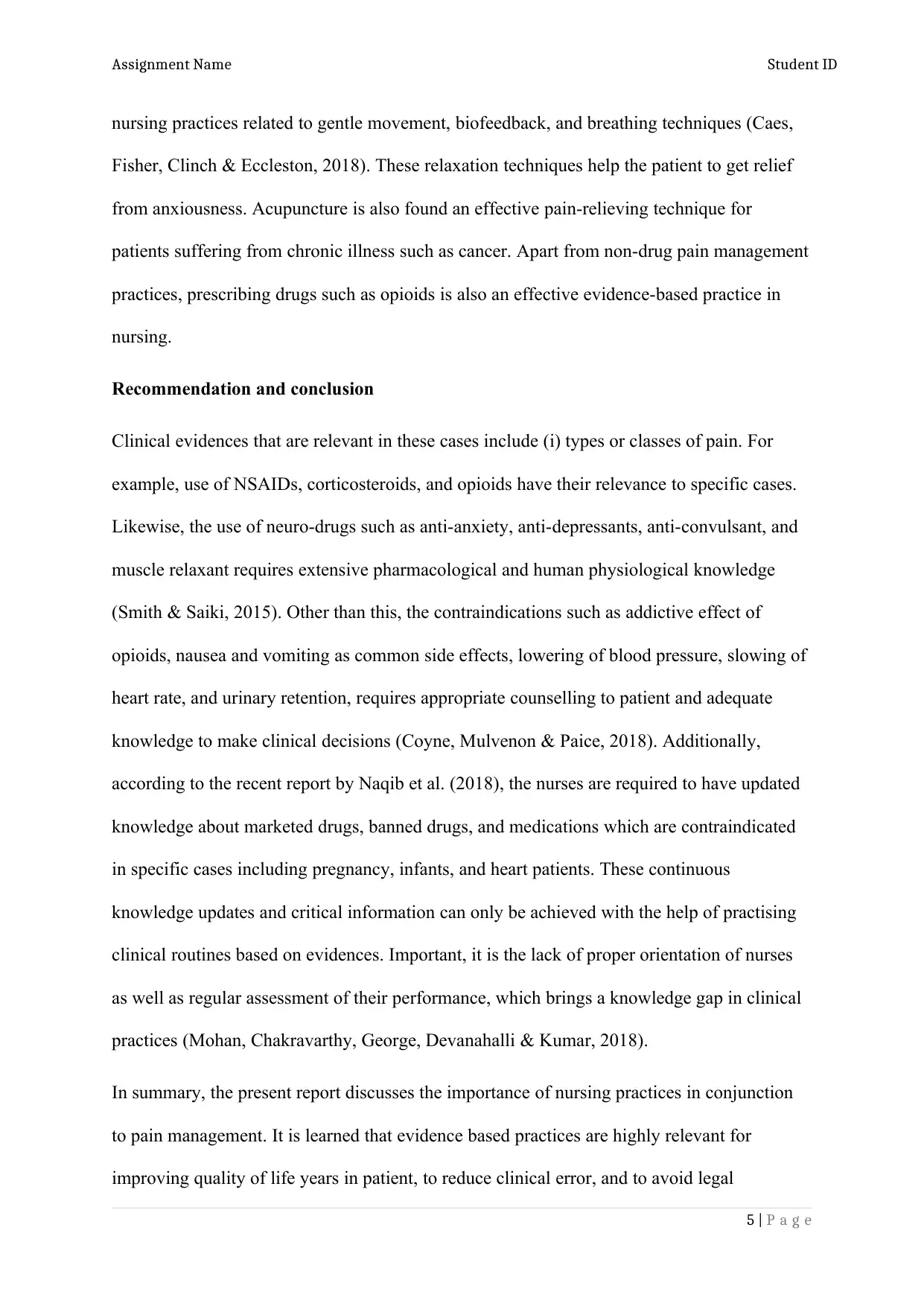
Assignment Name Student ID
nursing practices related to gentle movement, biofeedback, and breathing techniques (Caes,
Fisher, Clinch & Eccleston, 2018). These relaxation techniques help the patient to get relief
from anxiousness. Acupuncture is also found an effective pain-relieving technique for
patients suffering from chronic illness such as cancer. Apart from non-drug pain management
practices, prescribing drugs such as opioids is also an effective evidence-based practice in
nursing.
Recommendation and conclusion
Clinical evidences that are relevant in these cases include (i) types or classes of pain. For
example, use of NSAIDs, corticosteroids, and opioids have their relevance to specific cases.
Likewise, the use of neuro-drugs such as anti-anxiety, anti-depressants, anti-convulsant, and
muscle relaxant requires extensive pharmacological and human physiological knowledge
(Smith & Saiki, 2015). Other than this, the contraindications such as addictive effect of
opioids, nausea and vomiting as common side effects, lowering of blood pressure, slowing of
heart rate, and urinary retention, requires appropriate counselling to patient and adequate
knowledge to make clinical decisions (Coyne, Mulvenon & Paice, 2018). Additionally,
according to the recent report by Naqib et al. (2018), the nurses are required to have updated
knowledge about marketed drugs, banned drugs, and medications which are contraindicated
in specific cases including pregnancy, infants, and heart patients. These continuous
knowledge updates and critical information can only be achieved with the help of practising
clinical routines based on evidences. Important, it is the lack of proper orientation of nurses
as well as regular assessment of their performance, which brings a knowledge gap in clinical
practices (Mohan, Chakravarthy, George, Devanahalli & Kumar, 2018).
In summary, the present report discusses the importance of nursing practices in conjunction
to pain management. It is learned that evidence based practices are highly relevant for
improving quality of life years in patient, to reduce clinical error, and to avoid legal
5 | P a g e
nursing practices related to gentle movement, biofeedback, and breathing techniques (Caes,
Fisher, Clinch & Eccleston, 2018). These relaxation techniques help the patient to get relief
from anxiousness. Acupuncture is also found an effective pain-relieving technique for
patients suffering from chronic illness such as cancer. Apart from non-drug pain management
practices, prescribing drugs such as opioids is also an effective evidence-based practice in
nursing.
Recommendation and conclusion
Clinical evidences that are relevant in these cases include (i) types or classes of pain. For
example, use of NSAIDs, corticosteroids, and opioids have their relevance to specific cases.
Likewise, the use of neuro-drugs such as anti-anxiety, anti-depressants, anti-convulsant, and
muscle relaxant requires extensive pharmacological and human physiological knowledge
(Smith & Saiki, 2015). Other than this, the contraindications such as addictive effect of
opioids, nausea and vomiting as common side effects, lowering of blood pressure, slowing of
heart rate, and urinary retention, requires appropriate counselling to patient and adequate
knowledge to make clinical decisions (Coyne, Mulvenon & Paice, 2018). Additionally,
according to the recent report by Naqib et al. (2018), the nurses are required to have updated
knowledge about marketed drugs, banned drugs, and medications which are contraindicated
in specific cases including pregnancy, infants, and heart patients. These continuous
knowledge updates and critical information can only be achieved with the help of practising
clinical routines based on evidences. Important, it is the lack of proper orientation of nurses
as well as regular assessment of their performance, which brings a knowledge gap in clinical
practices (Mohan, Chakravarthy, George, Devanahalli & Kumar, 2018).
In summary, the present report discusses the importance of nursing practices in conjunction
to pain management. It is learned that evidence based practices are highly relevant for
improving quality of life years in patient, to reduce clinical error, and to avoid legal
5 | P a g e
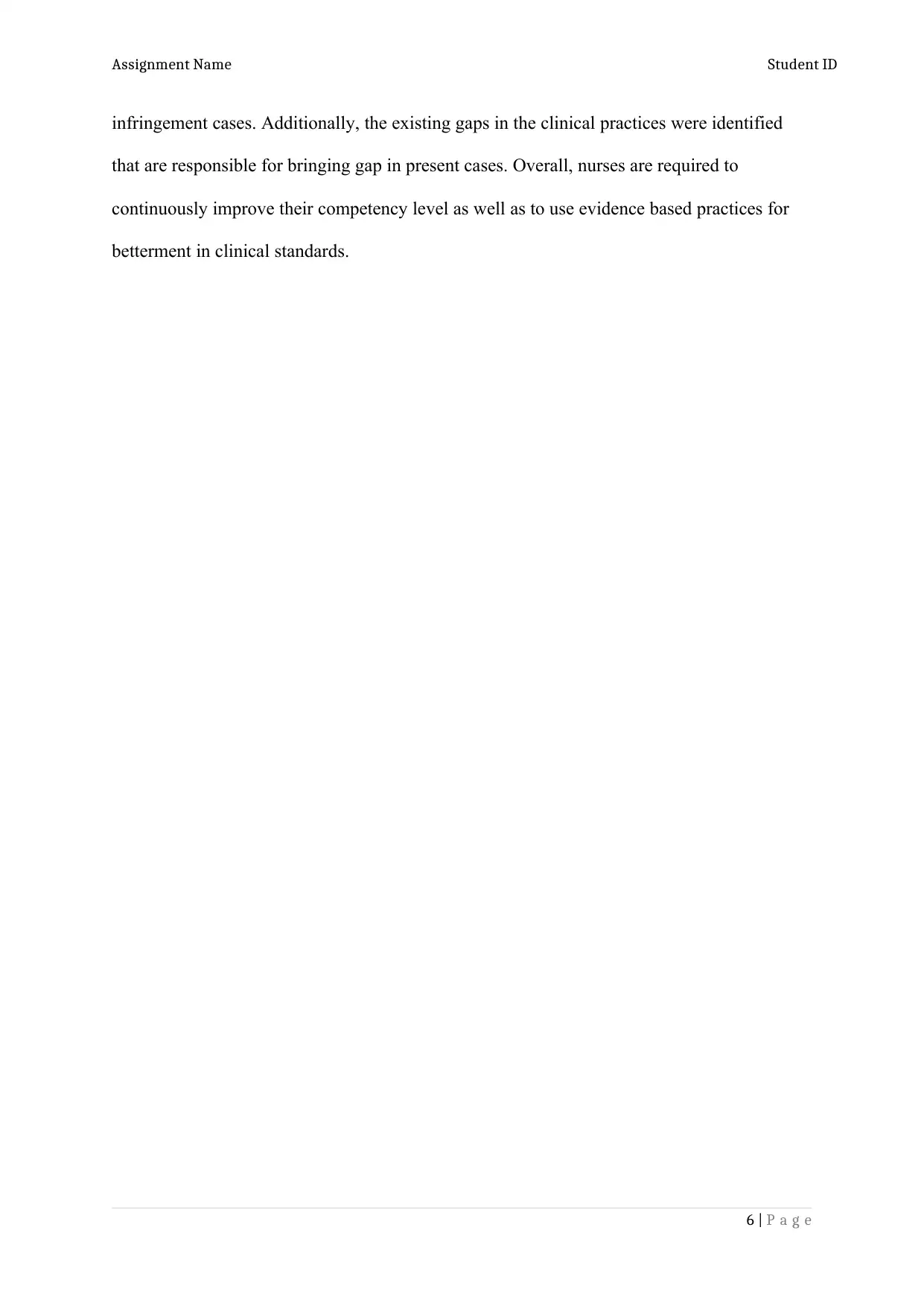
Assignment Name Student ID
infringement cases. Additionally, the existing gaps in the clinical practices were identified
that are responsible for bringing gap in present cases. Overall, nurses are required to
continuously improve their competency level as well as to use evidence based practices for
betterment in clinical standards.
6 | P a g e
infringement cases. Additionally, the existing gaps in the clinical practices were identified
that are responsible for bringing gap in present cases. Overall, nurses are required to
continuously improve their competency level as well as to use evidence based practices for
betterment in clinical standards.
6 | P a g e
⊘ This is a preview!⊘
Do you want full access?
Subscribe today to unlock all pages.

Trusted by 1+ million students worldwide
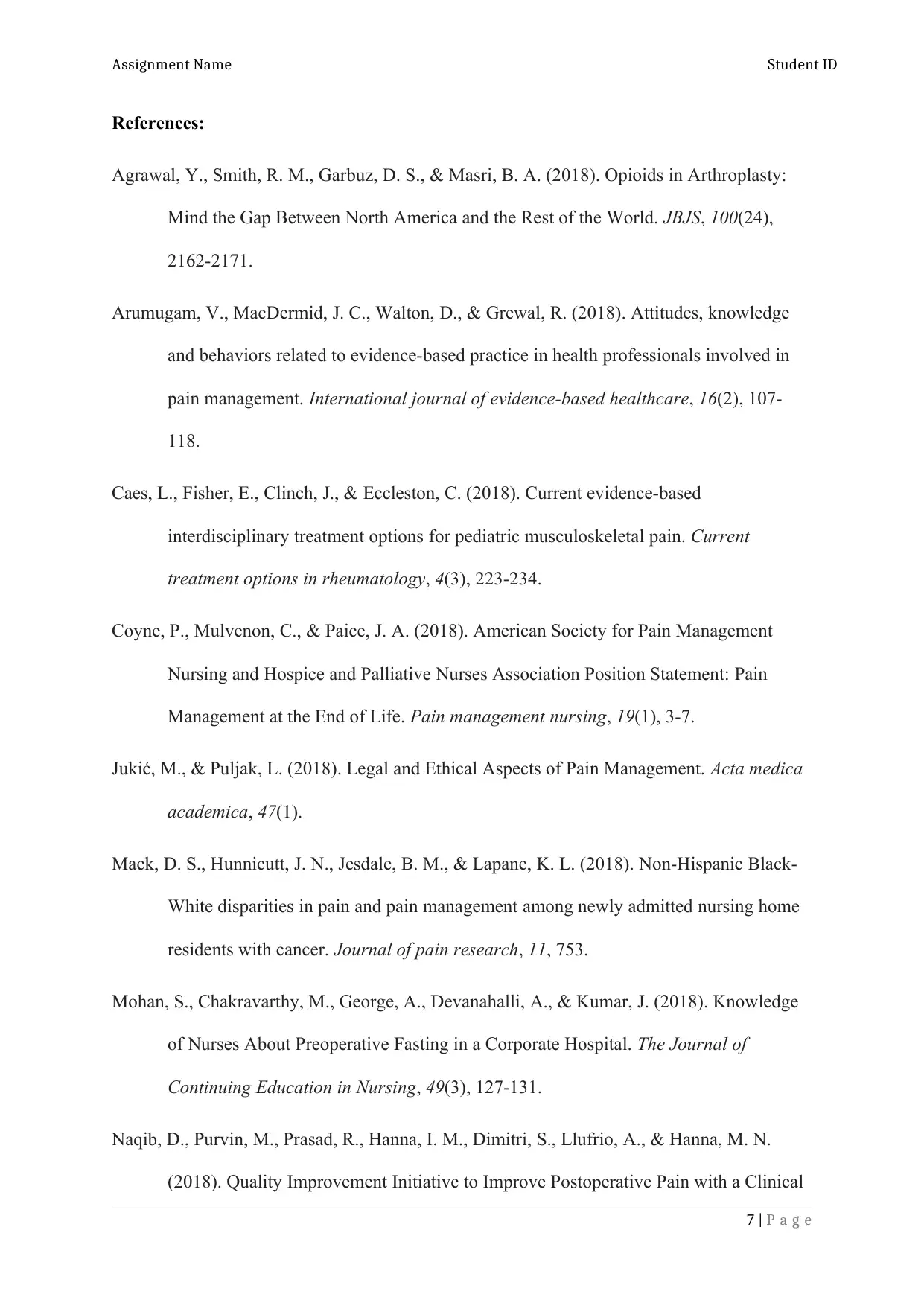
Assignment Name Student ID
References:
Agrawal, Y., Smith, R. M., Garbuz, D. S., & Masri, B. A. (2018). Opioids in Arthroplasty:
Mind the Gap Between North America and the Rest of the World. JBJS, 100(24),
2162-2171.
Arumugam, V., MacDermid, J. C., Walton, D., & Grewal, R. (2018). Attitudes, knowledge
and behaviors related to evidence-based practice in health professionals involved in
pain management. International journal of evidence-based healthcare, 16(2), 107-
118.
Caes, L., Fisher, E., Clinch, J., & Eccleston, C. (2018). Current evidence-based
interdisciplinary treatment options for pediatric musculoskeletal pain. Current
treatment options in rheumatology, 4(3), 223-234.
Coyne, P., Mulvenon, C., & Paice, J. A. (2018). American Society for Pain Management
Nursing and Hospice and Palliative Nurses Association Position Statement: Pain
Management at the End of Life. Pain management nursing, 19(1), 3-7.
Jukić, M., & Puljak, L. (2018). Legal and Ethical Aspects of Pain Management. Acta medica
academica, 47(1).
Mack, D. S., Hunnicutt, J. N., Jesdale, B. M., & Lapane, K. L. (2018). Non-Hispanic Black-
White disparities in pain and pain management among newly admitted nursing home
residents with cancer. Journal of pain research, 11, 753.
Mohan, S., Chakravarthy, M., George, A., Devanahalli, A., & Kumar, J. (2018). Knowledge
of Nurses About Preoperative Fasting in a Corporate Hospital. The Journal of
Continuing Education in Nursing, 49(3), 127-131.
Naqib, D., Purvin, M., Prasad, R., Hanna, I. M., Dimitri, S., Llufrio, A., & Hanna, M. N.
(2018). Quality Improvement Initiative to Improve Postoperative Pain with a Clinical
7 | P a g e
References:
Agrawal, Y., Smith, R. M., Garbuz, D. S., & Masri, B. A. (2018). Opioids in Arthroplasty:
Mind the Gap Between North America and the Rest of the World. JBJS, 100(24),
2162-2171.
Arumugam, V., MacDermid, J. C., Walton, D., & Grewal, R. (2018). Attitudes, knowledge
and behaviors related to evidence-based practice in health professionals involved in
pain management. International journal of evidence-based healthcare, 16(2), 107-
118.
Caes, L., Fisher, E., Clinch, J., & Eccleston, C. (2018). Current evidence-based
interdisciplinary treatment options for pediatric musculoskeletal pain. Current
treatment options in rheumatology, 4(3), 223-234.
Coyne, P., Mulvenon, C., & Paice, J. A. (2018). American Society for Pain Management
Nursing and Hospice and Palliative Nurses Association Position Statement: Pain
Management at the End of Life. Pain management nursing, 19(1), 3-7.
Jukić, M., & Puljak, L. (2018). Legal and Ethical Aspects of Pain Management. Acta medica
academica, 47(1).
Mack, D. S., Hunnicutt, J. N., Jesdale, B. M., & Lapane, K. L. (2018). Non-Hispanic Black-
White disparities in pain and pain management among newly admitted nursing home
residents with cancer. Journal of pain research, 11, 753.
Mohan, S., Chakravarthy, M., George, A., Devanahalli, A., & Kumar, J. (2018). Knowledge
of Nurses About Preoperative Fasting in a Corporate Hospital. The Journal of
Continuing Education in Nursing, 49(3), 127-131.
Naqib, D., Purvin, M., Prasad, R., Hanna, I. M., Dimitri, S., Llufrio, A., & Hanna, M. N.
(2018). Quality Improvement Initiative to Improve Postoperative Pain with a Clinical
7 | P a g e
Paraphrase This Document
Need a fresh take? Get an instant paraphrase of this document with our AI Paraphraser
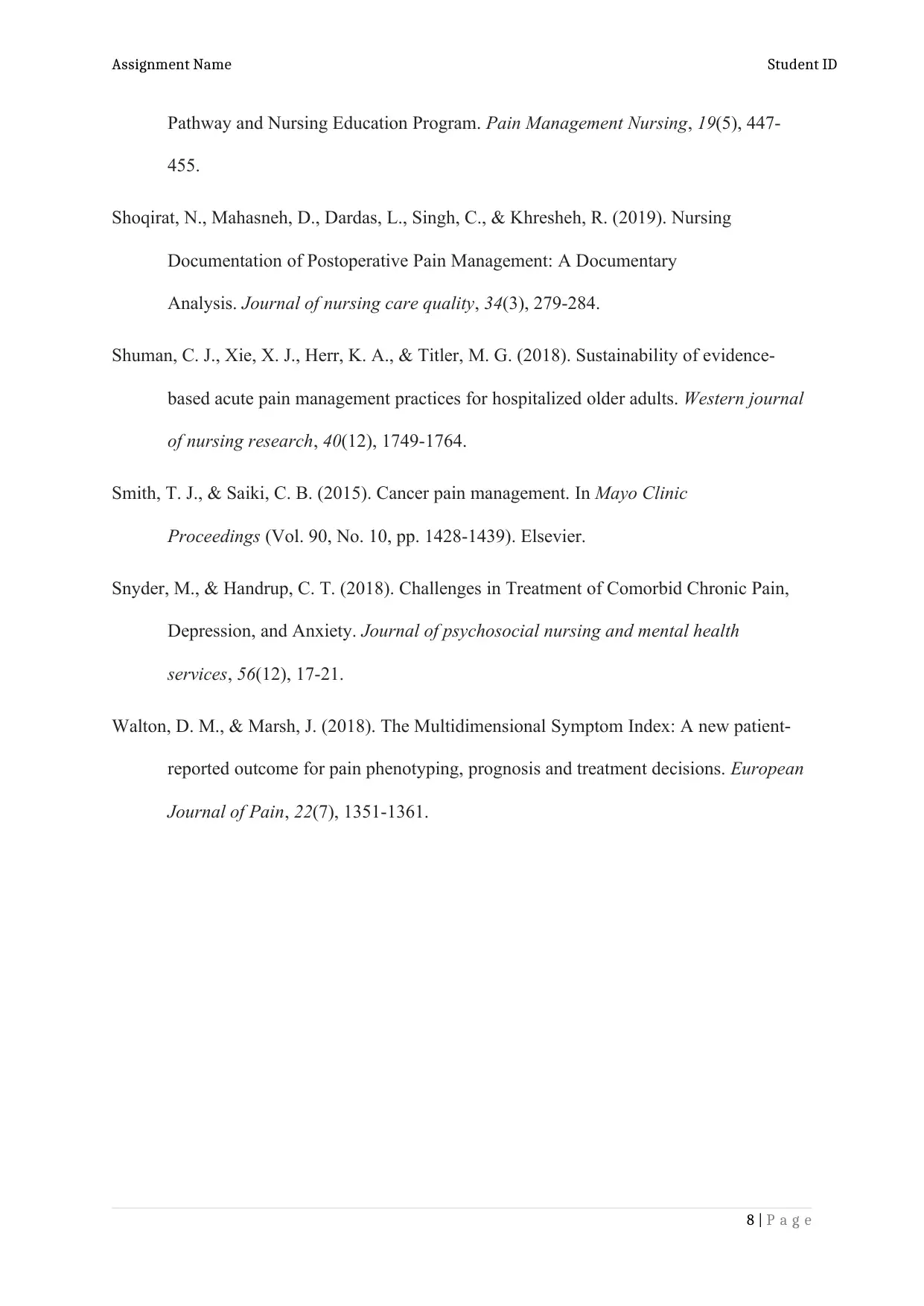
Assignment Name Student ID
Pathway and Nursing Education Program. Pain Management Nursing, 19(5), 447-
455.
Shoqirat, N., Mahasneh, D., Dardas, L., Singh, C., & Khresheh, R. (2019). Nursing
Documentation of Postoperative Pain Management: A Documentary
Analysis. Journal of nursing care quality, 34(3), 279-284.
Shuman, C. J., Xie, X. J., Herr, K. A., & Titler, M. G. (2018). Sustainability of evidence-
based acute pain management practices for hospitalized older adults. Western journal
of nursing research, 40(12), 1749-1764.
Smith, T. J., & Saiki, C. B. (2015). Cancer pain management. In Mayo Clinic
Proceedings (Vol. 90, No. 10, pp. 1428-1439). Elsevier.
Snyder, M., & Handrup, C. T. (2018). Challenges in Treatment of Comorbid Chronic Pain,
Depression, and Anxiety. Journal of psychosocial nursing and mental health
services, 56(12), 17-21.
Walton, D. M., & Marsh, J. (2018). The Multidimensional Symptom Index: A new patient‐
reported outcome for pain phenotyping, prognosis and treatment decisions. European
Journal of Pain, 22(7), 1351-1361.
8 | P a g e
Pathway and Nursing Education Program. Pain Management Nursing, 19(5), 447-
455.
Shoqirat, N., Mahasneh, D., Dardas, L., Singh, C., & Khresheh, R. (2019). Nursing
Documentation of Postoperative Pain Management: A Documentary
Analysis. Journal of nursing care quality, 34(3), 279-284.
Shuman, C. J., Xie, X. J., Herr, K. A., & Titler, M. G. (2018). Sustainability of evidence-
based acute pain management practices for hospitalized older adults. Western journal
of nursing research, 40(12), 1749-1764.
Smith, T. J., & Saiki, C. B. (2015). Cancer pain management. In Mayo Clinic
Proceedings (Vol. 90, No. 10, pp. 1428-1439). Elsevier.
Snyder, M., & Handrup, C. T. (2018). Challenges in Treatment of Comorbid Chronic Pain,
Depression, and Anxiety. Journal of psychosocial nursing and mental health
services, 56(12), 17-21.
Walton, D. M., & Marsh, J. (2018). The Multidimensional Symptom Index: A new patient‐
reported outcome for pain phenotyping, prognosis and treatment decisions. European
Journal of Pain, 22(7), 1351-1361.
8 | P a g e
1 out of 8
Related Documents
Your All-in-One AI-Powered Toolkit for Academic Success.
+13062052269
info@desklib.com
Available 24*7 on WhatsApp / Email
![[object Object]](/_next/static/media/star-bottom.7253800d.svg)
Unlock your academic potential
Copyright © 2020–2025 A2Z Services. All Rights Reserved. Developed and managed by ZUCOL.





